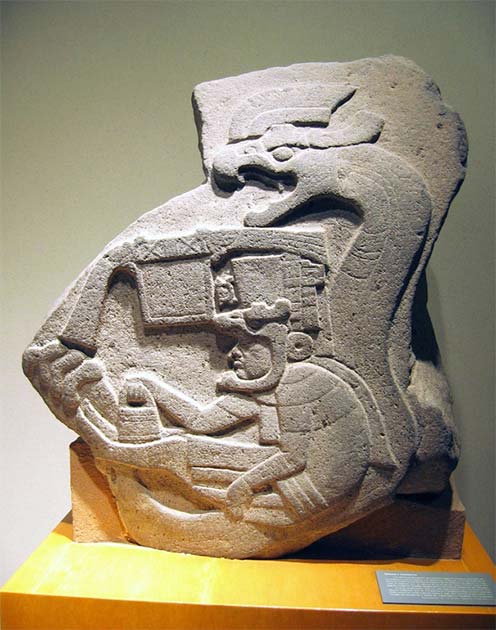
Why Are Mysterious Handbags Prevalent in Ancient Carvings Worldwide?
One of the more mysterious symbols that has been found in carvings from the ancient world is an image that looks uncannily like a modern-day handbag. The shape appears in depictions made by the Sumerians of Iraq, in the ruins of Turkish temples, in decorations of the Maori of New Zealand and in crafts made by the Olmecs of Central America.
Handbags can be seen in the art of disparate cultures from around the world and throughout time, with the first known instance of a handbag appearing at the end of the Ice Age. Once it’s been pointed out, its actually quite hard to avoid and the ubiquity of this mysterious symbol raises captivating questions about its significance and purpose in the ancient world.
What deeper meaning lies behind this recurrent and cross-cultural portrayal of handbags, and what might it reveal about the interconnectedness of humanity's ancient civilizations? In this exploration, we will delve into the symbolism and potential implications of this timeless emblem, seeking to unravel the secrets hidden within.
Handbags as Representations of the Cosmos?
It’s hard to deny that these supposed “handbags” look surprisingly similar to the contemporary purse. According to Scranton, the objects depicted within ancient art “typically feature a rounded handle-like top and a rectangular bottom, and may include varying degrees of additional details of texture or pattern.” The images sometimes appear as stand-alone objects; while other times they are depicted in the hand of a person, god or mythical being in a manner similar to how one would hold a basket.
- Cracking the Code to Discover Ancient Tarot Symbolism and Forgotten Universal Knowledge
- History of the 12,000-Year-Old Swastika: Origin, Meaning and Symbolism
One possible theory for the proliferation of this image is that it’s a simple and straightforward representation of the cosmos. The semi-circle of the image—which appears to be the bag’s strap—represents the hemisphere of the sky. Meanwhile, the solid square base represents the earth.
“In ancient cultures from Africa to India to China, the figure of a circle was associated symbolically with concepts of spirituality or non-materiality, while that of a square was often associated with concepts of the Earth and of materiality,” continued Scranton. Thus, some argue that the image is used to symbolize the (re)unification of the earth and sky, of the material and the non-material elements of existence.

Could the mysterious handbag really represent the cosmos? Assyrian relief carving from Nimrud, 883 to 859 B.C. (Public domain)
The Oldest Depictions of Handbags
One of the earliest instances of the handbag motif can be seen in the ruins of Göbekli Tepe, located at the top of a mountain ridge in southeastern Turkey. Dating back to approximately 11,000 BC, Göbekli Tepe is one of the oldest temple complexes ever discovered. While the exact purpose of the mountain sanctuary is unknown, it appears that the temple may have served as a site for religious sacrifices since archaeologists have unearthed many butchered animal bones.
The walls and pillars of the temple at Göbekli Tepe are decorated with finely carved animals, gods, and mythical creatures, perhaps in an effort to portray the many different creations of the cosmos. Nestled among this tapestry of carvings from another era, appear to be three handbags, adding an extra layer of mystery and intrigue to the richly adorned walls and pillars of the ancient sanctuary.
Experts believe that early religions worshiped the fundamental elements of life on earth. Therefore, “the three Göbekli Tepe handbags, taken as an early form of those icons, could be said to symbolically define the site as a temple,” argued Scranton.

Pillar 43 from Gobekli Tepe in Turkey shows three ‘handbag’ carvings along the top. (Alistair Coombs)
Carvings of Handbags Can Be Found from the Middle East to South America
Elsewhere, the handbag image shows up with striking similarities in two stone reliefs, one made by the Assyrians of ancient Iraq sometime between 880 to 859 BC and the other made by the Olmecs of ancient Mesoamerica sometime between 1200 to 400 BC.
In both of these images, a male figure carries the handbag in his hand, as if it were a basket or purse. “When used in Assyrian art it is said the purse holds magic dust. When depicted in Olmec art they postulate it contains herbs for getting high,” explained Freeborn in Noahsage. This suggests that handbags may have been a standard of measurement uniquely discovered by both cultures.

Olmec Monument 19, from La Venta, Tabasco, shows a man holding the handbag in his hand. (Xuan Che / CC BY 2.0)
In distant New Zealand, another intriguing instance of imagery which appears to represent handbags surfaces within the cultural context of the Maori people. According to Maori mythology, a revered hero undertook a remarkable journey to the abode of the gods, where he acquired profound wisdom. Upon his return to Earth, this heroic figure was said to be carrying three baskets filled with this divine knowledge.
- Eye of Horus: The True Meaning of an Ancient, Powerful Symbol
- Did the Ancient Egyptians Create Art as a Way to Manifest Reality?
These Maori “handbags” bear a striking resemblance to the Göbekli Tepe artifacts, both symbolizing a profound sense of reverence and gratitude for the wisdom and insights believed to be bestowed by higher powers. These depictions not only serve as tangible representations of ancient narratives but also highlight the universal human inclination to celebrate and preserve the gifts of celestial inspiration.
Moreover, ancient Egyptian art reveals intriguing handbag-like representations within hieroglyphs. In these depictions, the handbag serves as a divine abode for gods and goddesses. The purse's straps are symbolized by the domed poles of portable tents, while the square bottom represents the cloth or animal skins draped across these poles.
Remarkably, this structural resemblance draws parallels with other ancient architectural designs, such as the Native American teepee and the central Asian yurt, underscoring the universality of this symbol across diverse cultures and eras.
These numerous occurrences of the handbag symbol suggest its role as a cosmological representation camouflaged within the ordinary guise of a household item, specifically a basket. This subtle approach aimed to facilitate comprehension among the general populace, effectively bridging the gap between the profound cosmic concepts and the everyday experiences of ordinary people.
Top image: Assyrian relief carving, circa 883 to 859 BC, which includes a representation which looks surprisingly similar to modern-day handbags. Source: Public domain
References
Freeborn, B. L. 1 July 2013. “The Odd Little Purse in Olmec and Assyrian Art” in Noahsage. Available at: https://noahsage.com/2013/07/01/the-odd-little-purse-in-olmec-and-assyrian-art/
Scranton, Laird. 21 February 2016.“Perspectives on Ancient Handbag Images” in Lost Origins.
Tinfoil Hat. 10 June 2014 “Ancient Purses and Balls of Power” in Tinfoil Hat Lady. 10 June 2014. Available at: https://tinfoilhatlady.com/2014/06/10/ancient-purses-and-balls-of-power/
















Comments
Far too much religious/ cosmology fuss. The earliest or very early tool was the bag. There are many refs to stone tools because they survive millennia easily. But long before that we made tools from more easily worked materials: wood (digging sticks, staves) and BAGS of large leaves, grasses, skins. Essential as for most of our story we have been mobile gypsies so carrying stuff vital. Food, babies, and lined with clay, water, then fire. Carrying a bag would be a s strandard as wearing something around the loins.
Shan Morgain www.mabinogistudy.com
Thank you! I’m a farm person myself, along with being an amateure historian, the more ancient the history the better. The first time I saw something about the “mysterious handbags” I enlarged the image and thoughtt BUCKET. Humans figured out basic animal husbandry first, then horticulture. In the beginning, you move the animals to water . You have to move the water to the plants. Once how to make buckets as an alternative to unsealed baskets or crockery was figured out, not only could water be taken to crops, but hundreds of other things could be transported easily. Modern humans think of buckets as being made of hard, “workable” substances like metals (and now plastics). But buckets have also been made from wood & bark, other plant parts & leather. One of thejokes about paleontology is “if you have no idea what the object was for, it must be of religious significance”. This is a case in point, even tho having important beings ( religious or not), carrying buckets makes perfect sense. During the invention of agriculture, the ability to grow plants where you wanted them was impressive – had to have been the sort of thing that the ‘immaterial’ world was responsible for & protective of. The occurance of the buckets in association with representations of useful plants would be consistent with this.
Wow there’s so many fantastical ideas about what these represent!
Sorry to be a killjoy (some of your ideas are way more interesting), but the reality is actually quite boring by comparison.
The “handbags” of the Apkallu or “Wise Ones” (not the Annunaki as some here have claimed) are called dālum in Assyrian, which indicates a bucket for drawing water. That these are synonomous with banduddû is confirmed in an Assyrian medical lexion which lists both as a “drawing bucket”, many of which have been unearthed by archaeologists. They’re made of various metals and in different shapes but they’re all just buckets.
The most amusing part about this article is that there is an ealier article on this very site which is quite upfront about the fact that banduddû are known to be containers:
Ancient Origins Banduddu
The author of this article might’ve bothered to read the first paragraph of Freddy Silva’s article prior to speculating about the purpose of the “handbags”.
The pinecone looking object in the other hand, which is being used to manually polinate the tree is either,
Date Palm Male Inflorescence
This is most common among scholars.
or
Giant Fennel
This is most likely the plant being cultivated seeing as depictions of silphium found on ancient Cyrene coins are almost identical to the so-called sacred tree of the Assyrian reliefs.
What’s really being depicted, is simply agriculture, the most important industry for an urban centre to exist. Not so mysterious after all!
It’s an aspersorium, vessel for holy water or another sacred liquid, and the figure holding it and dispensing its contents it is a priest.
Nick
This made me chuckle.
Pages